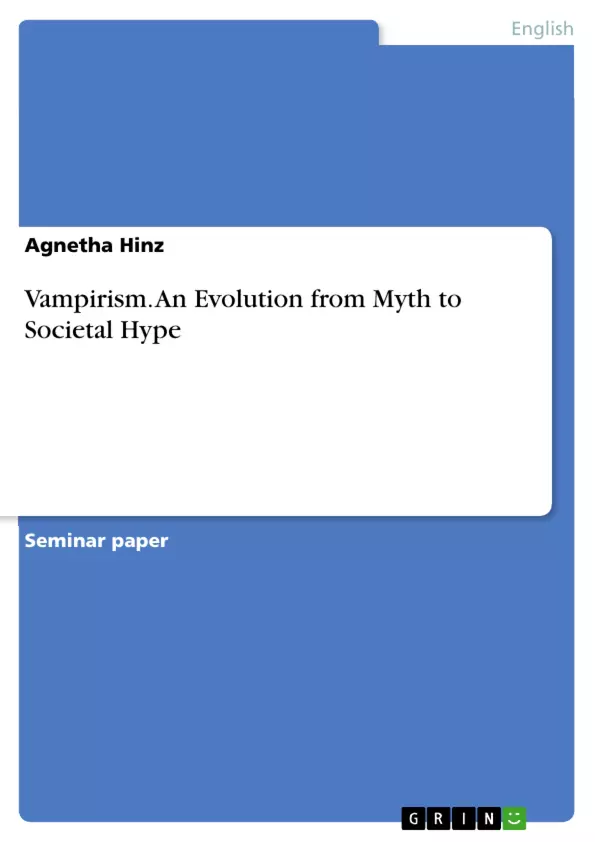Vampires – Ever since, they exist in human belief. During the ages the image of the vampire underwent a massive change. Simply regarding the different genres in which the cinematic vampire appears it becomes clear that those changes are primarily based on the changes in society.
The following is aimed at describing these changes and exploring their causes by analyzing the vampire’s characteristics in its relation to the respective cultural background. First, the origin of the vampire myth will be discussed. Furthermore the most popular literary character originating from the Gothic horror genre, Count Dracula by Bram Stoker, will be examined to point out the changes of the vampire image as well as the cultural message behind the figure Dracula. The paper will take an additional look at the development of the concept of the vampire and the underlying cultural trends by analyzing the early cinematic vampires Count Orlok from Nosferatu and Dracula by Tod Browning.
Finally, the work will create a reference to the present image of the vampire by analyzing Edward Cullen, the protagonist in Stephenie Meyer’s Twilight. The result of the analysis is intended to reflect the changeableness of the vampire concept as well as show to what extent the vampire can be used as a medium to represent the respective societal needs, trends and changes.
Inhaltsverzeichnis (Table of Contents)
- INTRODUCTION
- THE ORIGIN OF THE MYTH OF VAMPIRISM
- THE LITERARY VAMPIRE IN HIS BEGINNING: BRAM STOKER'S DRACULA
- DRACULA GOES HOLLYWOOD
- THE FIRST FILMINGS: THE VAMPIRE AS MONSTER
- VAMPIRISM MEETS POP-CULTURE: The TwiliGHT – HYPE
- CONCLUSION
Zielsetzung und Themenschwerpunkte (Objectives and Key Themes)
This paper aims to explore the evolution of the vampire concept through the ages, analyzing how its characteristics and cultural significance have changed in relation to societal needs and trends. It will examine the vampire's journey from a mythical figure to a popular cultural icon, highlighting the underlying cultural messages and anxieties embedded within each iteration.
- The historical and cultural origins of the vampire myth
- The evolution of the vampire image in literature, particularly through Bram Stoker's Dracula
- The impact of cinematic representations of the vampire, including early films like Nosferatu and Dracula
- The contemporary vampire as a reflection of modern societal anxieties and desires, exemplified by the Twilight series
- The role of the vampire as a medium for exploring themes of sexuality, death, and cultural anxieties.
Zusammenfassung der Kapitel (Chapter Summaries)
- INTRODUCTION: This chapter introduces the concept of the vampire as a constantly evolving figure, highlighting its enduring presence in human imagination and its ability to adapt to different cultural contexts. The paper's objectives and scope are outlined, focusing on the vampire's historical and cultural significance.
- THE ORIGIN OF THE MYTH OF VAMPIRISM: This chapter delves into the origins of the vampire myth, exploring its diverse interpretations across different cultures. It examines the historical and linguistic roots of the term "vampire" and discusses the various beliefs and practices associated with vampires in ancient Greece, Bulgaria, and Romania. The chapter concludes by connecting the emergence of the vampire myth to human anxieties about death, illness, and the unknown, highlighting the role of socio-cultural factors in shaping these beliefs.
- THE LITERARY VAMPIRE IN HIS BEGINNING: BRAM STOKER'S DRACULA: This chapter focuses on the iconic vampire character created by Bram Stoker, Count Dracula. It analyzes how Stoker's novel, written during the Victorian era, reflects the cultural anxieties and social norms of the time, particularly regarding sexuality and morality. The chapter explores how Dracula embodies both the allure and the danger of unchecked sexual desire, highlighting the novel's contribution to shaping the modern vampire image.
Schlüsselwörter (Keywords)
The paper explores the evolution of the vampire concept, analyzing its cultural significance and its representation in literature and film. Key themes include vampire mythology, cultural anxieties, sexuality, death, Victorian literature, cinematic representations, and contemporary pop culture. The paper draws on research findings from various disciplines, including folklore, history, literature, and film studies, to provide a comprehensive overview of the vampire's cultural journey.
- Quote paper
- Agnetha Hinz (Author), 2013, Vampirism. An Evolution from Myth to Societal Hype, Munich, GRIN Verlag, https://www.grin.com/document/302888



